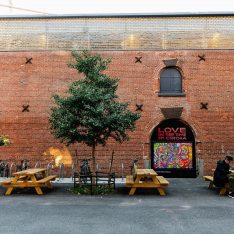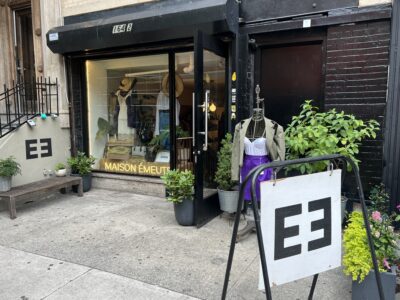Illustration by Joelle McKenna
Brooklyn theater went dark in 2020, but it didn’t die
How St. Ann's Warehouse, the Brick and Brooklyn Children's Theater navigated a year that can only be described as pure absurdist tragedy
The year 2020 brought a great deal of misery to many of the world’s industries. But it’s possible that nowhere is that felt more acutely than the theater, which tends to exist on the edge financially even in the best of times. But the very thing which separates theater from, say Hollywood, is what’s made it more difficult to overcome in a pandemic: Theater is live.
Brooklyn Magazine visited three of Brooklyn’s longest running and most successful theater companies to see how they’re faring, and what they are looking forward to in 2021.
St. Ann’s Warehouse
Since 1980, not-for-profit St. Ann’s Warehouse has been a cultural beacon. Based in DUMBO, they are known globally for their innovative programming. What started with classical music and puppet theater evolved into a home for thousands of international artists: St. Ann’s presented the recent “Oklahoma!”, directed by Daniel Fish, that went to Broadway in 2019. Before that, St. Ann’s presented a production of “A Streetcar Named Desire,” imported from the Young Vic in London, that starred Gillian Anderson, Ben Foster, and Vanessa Kirby.
In normal times, funding comes from a combination of box office income, grants and partnerships. But these aren’t normal times. St. Ann’s had just wrapped a production of “Hamlet” featuring Ruth Negga and the Gate Theater of Dublin on the Monday before the lockdown went into effect.
“We were supposed to be bringing back a production of ‘The Jungle,’ which was a beautiful production we did with a company called Good Chance Theater, about refugees in Northern France, set in an Afghani restaurant in a refugee camp,” says Artistic Director Susan Feldman. “They were supposed to come that Monday. We basically had to cancel everybody coming. We thought we would be closed for about two weeks.”
“The Jungle” was supposed to be part of a three month long project called Crossing Borders featuring concerts, talks about immigration and immigration law and exhibits that would then go on tour.
For the first three months of lockdown, St. Ann’s didn’t do anything. “Like many people, we were in a state of shock and we didn’t want to just start throwing up archival materials,” says Feldman. They went from a company of 20 full-time staff to a team of 11. Their budget was slashed in half too, reverting to 2015 levels. They lost three people close to the organization, including friend and collaborator Jane Walentas, who died in July. Nicknamed the ‘First Lady of DUMBO,’ Walentas was one of the early pioneers of the area determined to make it a desirable place to live and work. “We were reeling,” Feldman says.
Fortunately for St. Ann’s, the company received federal funding and private donations, which helped them survive. “I need to give a big shout out to our Board of Directors,” Feldman adds. “They stepped up in a big way.”

St. Ann’s
The spark to get things moving again came from The Black Lives Matter movement last summer and fall. While they couldn’t bring anyone into their building, the walls of St. Ann’s were given over for purposes of projection. They worked with a street photographer named Kobie Procter who organized a series of photographs from the protests and projected it on their outside walls. They utilized their rooftop and worked with musicians to give impromptu performances. They went into Main Street Park and performed, using masks and social distancing. Their huge archways, normally utilized for marketing purposes, were turned into a gallery for Columbian artist Miguel Amortegui, entitled “Love in the Time of Corona.”
Feldman remains optimistic. She feels that venues and organizations such as St. Ann’s will open sooner than Broadway because they have the means to make conditions safer for the audiences. They have the ventilation in place, they would require masks and social distancing and, like restaurants, they could begin again in a somewhat limited capacity, something not feasible at Broadway’s scale.
“When the weather gets warmer and the vaccine becomes available, I do see a time when St. Ann’s can slowly begin to open up again and eventually go back to what we had before,” says Feldman. When asked if there were any specific plans for productions or events in 2021, Feldman says coyly, “Yes, there are. But I can’t tell you.”
The Brick
Theresa Buchheister took over the role as The Brick Theater Company’s artistic director in a rather unfortunate time: January of 2020. It started off as an exciting time for the 18-year-old Williamsburg theater, one of nine Brooklyn companies participating in the Exponential Festival. Buchheister estimates that through the festival she saw between 50 and 60 shows that month, which is amazing as January is typically a tough month for theater. Six weeks later, the bottom fell out.
“One of the hardest things was having to have conversations with the hundreds of artists who were programmed to be part of our year, but also not knowing,” she says. “At first it was like, ‘We’ll just postpone.’ And then it’s, ‘No, we’re cancelling.’ and then it’s, ‘Oh my God, we’re not going to do anything else this year’!”
Financially, this put the Brick in a huge bind. Unlike other theaters, the Brick had done little in terms of establishing relationships with corporations or individuals who might help defray some of the costs associated with losing an entire season. “We had nothing to fall back on,” she says. “I wasn’t even sure we would make it through April!”
The Brick received some federal funds in April but has seen nothing since then. As Buchheister puts it, “I know it’s been hard for everyone and we’re like phase a billion when it comes to re-opening.”
As with St. Ann’s, a turning point for the Brick came during the Black Lives Matter movement. “I hadn’t even seen another human being until then,” Buchheister says. “It wasn’t until I was actually out with thousands of people that I was around people for the first time in months.”
Energized by the outpouring of emotion in and around her community, Buchheister opened the doors to the Brick to allow demonstrators to use the bathrooms. At first she had no sanitizers or wipes but once realized what she was doing, people from all over came together to bring those items to her and soon they were able to let people in under a strict protocol. “It was a real bonding moment,” she says.
Like many other companies, Buchheister worked out a deal with the landlord of The Brick, who was sympathetic to their plight. Whereas some companies simply shut down and waited for the pandemic to end, The Brick was live streaming as early as March 22 in an effort to raise awareness, keep the company going and also pay their artists. As the year comes to an end, Buchheister counts that they’ve done over 39 shows.
Buchheister suspects live performances will be off the table until the Fall. Her staff is currently just herself and two collaborators. Often they don’t draw much of a salary at all. But there is hope. They plan to open an audio division of the company to do podcasts, which would employ artists and help bring in revenue. They plan to hire four more staff members. They also started doing educational programming in June, which they will keep as part of their curriculum. For the most part, however, they’re in wait-and-see mode.
Brooklyn Children’s Theater
At the Brooklyn Children’s Theater, the kids aren’t just the audience. They act and star in the shows, rehearsing and performing for their families, friends and the outside community.
“What makes us unique is that we take great efforts to bridge communities,” says Amy Graves, founder of the company now entering its sixteenth year. “We take kids from homeless shelters and put them alongside kids from Park Slope. It’s more than putting on a musical theater production. It’s working with someone who might not look like you, building empathy and trust and risk-taking.”
Brooklyn Children’s Theater was in the middle of rehearsing 19 shows when Covid hit. (The company usually performs at the Brooklyn Music School in Fort Greene.) They immediately went from a staff of six to a staff of two. Shows that had been planned for March, April, May and even June, were cancelled. It’s bad enough to have to tell adults that they’re not going to be able to perform but with children it becomes even harder.
“Kids don’t care that the world is shutting down,” Graves laughs. “They still want to do their show. So we had to explain to them what was happening.”
Perhaps because of the students’ need for instant (or at least impending) gratification, Brooklyn Children’s Theater responded even more quickly than others. They started doing movie musicals like The Missing Cow and Queen Bea with the kids over Zoom.
The directors and choreographers rallied teach the kids their parts over video and then volunteers would come in and edit the pieces together into short movies. The staff learned how to use iMovie and GarageBand to make the shows work. “It was a real group effort, people really wanted to come help the kids, because they knew how much the kids were counting on it. It was a magical community effort in that regards,” says Graves.
Brooklyn Children’s Theater fared better than most companies did during the lockdown. They had already collected the tuition, plus there were grants and donations, which they applied for and received. Their landlords worked with them on a 25 percent reduction in rent. But perhaps the most gratifying of all were the contributions given by the community. “We had a lot of people showing us a lot of love,” Graves says.
But love can only go so far and they, like everyone else, face 2021 under daunting conditions. Graves fears that Zoom may have reached its saturation point, especially for kids. The rent reduction expired December 31st. Their two studios were built for soundproofing, which means no windows and no real ventilation, so there are no plans to go back inside until the vaccine has made it safe. Their programming has to be slashed in order to meet the realities of the budget and they may have to furlough the rest of the staff come summer.
Still, Graves remains cheerily upbeat.
“Thankfully a lot of our big donors work in finance and they haven’t had a big financial hit. They’re doing OK and they’re still throwing us love,” she says. “Plus I’m hearing from people whose kids we taught fifteen years ago and they’re giving what they can. They’re saying, ‘You matter’!”
You might also like 


























